Harold Barkley
PORTRAIT OF THE ARTIST
HAROLD BARKLEY WAS one of the greatest and most innovative hockey photographers, and his work captures the spirit of the golden era of the game. Some of the most important images in hockey history might never have been captured if Barkley had pursued his original career plan, which was to follow in his father’s footsteps and become a commercial artist. But when he was eighteen years old, his hands got caught in a rock-crushing apparatus at a Quebec mine and five of his fingers were damaged—doctors told him he would never use them again. However, a determined Barkley built model trains to remind himself that he could accomplish detailed tasks even with his mangled hands, and a camera given to him by an uncle gave him a new focus on life.
Harold Barkley (Hal to his friends and family) was born in Victoria, British Columbia, on October 24, 1920. His family moved to Toronto in 1925 after his father passed away, and Barkley was preparing to attend the Ontario College of Art when he suffered his mining accident. In the winter of 1942 (just as the National Hockey League was becoming a six-team circuit), he turned his attention to photography and snapped his first black-and-white hockey photographs. He worked at the Miller Photo Agency and then as a freelance photographer for a number of magazines (including those dedicated to sports) and also for the Toronto Star news-paper. In 1958 Barkley became a full-time member of the Star staff, working as much as seven days a week, starting his job at eleven a.m. and not leaving until late at night when everything was done.
Sports photographers were gaining in prominence and when the iconic Sports Illustrated magazine made its debut in 1954, the demand for action color photography continued to grow. In the hope of boosting circulation, the Star began printing color hockey photos in its Star Weekly supplement. Barkley saw a future market but he had to figure out how to capture the action. During a trip to Detroit, Barkley noticed that a photographer working for the Detroit Free Press was using a strobe light instead of the usual flashbulbs to take his shots. The results were impressive, even with black-and-white film. Barkley then learned of a new strobe lighting system that had been developed in Sweden and he met with a Swedish engineer who helped design a system to capture on-ice hockey action in color. In the era before television crews arrived with their bright lights, poor lighting inside hockey arenas made color action photography virtually impossible. Barkley’s new strobe system largely solved that problem and set in motion a technological revolution in hockey photography.
Soon afterward, Barkley set up his strobes along the glass at the ends of the ice, attached to two cameras that are often clearly visible in the photos and were only allowed at that one spot in the arena. The strobes were wired and synchronized to the camera shutter so that when he clicked, the flashes highlighted one area of the ice for that split second and in effect “stopped” the action, capturing an image with incredible sharpness, detail, and light. Using Kodak film, Barkley took many of his shots as large-format transparencies (roughly four inches by five inches), which made them easier to reproduce. Using a large-format camera allowed Barkley to shoot a bigger negative of better quality, and with the strobes in place he could capture the action at 1/1200th of a second.
Barkley’s entire system used an estimated 350 pounds of equipment that was stored in specially designed cases and that he transported with him to games in each of the Original Six cities. Since he worked for a Toronto newspaper and lived in Oakville, Ontario, most of Barkley’s shots come from Maple Leaf Gardens. But he also traveled to Boston, Chicago, Detroit, Montreal, and New York to take photographs in those cities’ arenas. It was a lot of effort but the results Barkley produced were spectacular and captured some of the best players and plays of that era.
Barkley encountered some difficulties in doing his job. One night the ever-finicky Jacques Plante became agitated. The Canadiens goaltending legend skated over to where Barkley had his strobes set up and knocked on the glass. He told the photographer in no uncertain terms that the flash was bothering him. Referee Frank Udvari ordered Barkley to stop shooting. This incident forced the photographer to work out the kinks with his system in the pregame warm-up to ensure there were no further complaints from goalies. At another game in New York, a woman grabbed one of Barkley’s lights and hid it under her seat, claiming it was distracting the players. At the Chicago Stadium one night, a fan poured a bottle of soda pop over Barkley’s equipment and the sparks that resulted gave the fans an extra light show.
As Barkley was the inventor of color hockey-action photography, his collection was one of the only places to find high-quality work in this field from the late fifties through the late sixties. Much of his best material appeared in the Star Weekly across Canada under the headline “Stars of the World’s Fastest Game.” Each weekend during the hockey season, fans collected the large photos and pasted them into scrapbooks. Youngsters would pin up images of their favorite players in their bedrooms. Barkley’s best shots adorned the cover of Hockey Illustrated, a popular magazine in the sixties, and his work also appeared in Sports Illustrated, The Sporting News, Sport, and Time. Hockey books (biographies of Bobby Hull, Red Kelly, and Stan Mikita, for instance) usually had a Barkley photo on the cover. The Star also published two collections of Barkley’s photos in the mid-sixties (one with four-by six-inch photographs and the other with four-by four-inch shots, on high-quality paper with captions, a total of ninety action shots altogether). A mint-condition set of each is worth at least three hundred dollars today. How I wish I had kept mine! In 1969 a British publisher put together a colorful, large-sized book featuring much of Barkley’s best work, with text by Trent Frayne, one of Canada’s foremost sportswriters. Simply titled Hockey, it marked the first time a book was made up solely of hockey photos and is still one of the most popular items at collector shows.
Much of Barkley’s success is due to his keen sense of timing—he knew when to click the shutter. The late Jim Hunt, a sportswriter who often worked with Barkley, said his colleague studied the players he was photographing to know their tendencies. Bobby Hull, a Barkley favorite, was a good example and is the subject of one of Barkley’s best shots. The blond Chicago Black Hawk star was the most entertaining player of the era and the purest goal scorer for more than a decade. Barkley captured the “Golden Jet” at his best as he tried to beat Johnny Bower of the Toronto Maple Leafs during a game at the Gardens. The photo shows the puck in mid-air, already past a sprawled Leafs netminder and about to go just wide of the left goalpost. It won a national newspaper award and came about because Barkley understood his subject so well. He knew Hull would veer left before letting go of his howitzer shot. Similarly, he knew that Gordie Howe would snap a quick wrist shot as soon as he got close to the opposing goal, and Maurice “Rocket” Richard could let a drive go at any point after he crossed the blue line. Preparation gave Barkley terrific action shots of hockey’s great legends like Johnny Bucyk, Rod Gilbert, Glenn Hall, Gordie Howe, Dave Keon, Ted Lindsay, Frank Mahovlich, and a youthful Bobby Orr, to name just a few Hall of Fame players he saw through his lens.
Being able to pick the exact moment to click the shutter was important for Barkley since he did not take too many shots—perhaps as few as fifteen or twenty in a game. In contrast, today’s digital technology allows photographers to take hundreds of shots per game. Barkley also had a knack for capturing the puck in his photographs, and where the black disk goes there is sure to be action.
Another distinctive feature of Barkley’s work is the look of intensity on the players’ faces. In an era without helmets and masks, Barkley captured some of the best faces of the era—hard-nosed players like Bill Gadsby, Ted Green, Harry Howell, Tim Horton, Jacques Laperrière, Pierre Pilote, and Allan Stanley. Of course, none provided better grimaces for Barkley’s cameras than netminders like Johnny Bower, Gump Worsley, Eddie Giacomin, Jacques Plante, and Terry Sawchuk (the latter two were also captured wearing their primitive face masks). Stitches, scars, missing teeth, and crew cuts defined the times, and all of these feature up close in Barkley’s best efforts. The photos reveal the faces of focused athletes who did not take the privilege of playing in the NHL lightly.
The uniforms of the Golden Era were especially interesting for their use of primary colors and uncomplicated logos, and it was easy to recognize each of the six clubs when the players were on the ice. It was Barkley who realized that he got a better-quality photograph when one team wore a dark uniform and the other wore a lighter color (often both teams wore dark sweaters when games were not being photographed, broadcast, or recorded), and he suggested this permanent change that was adopted by the NHL just as hockey was becoming a televised sport.
If fans appreciated Barkley’s great work, so did the coaches and players. Toronto coach Punch Imlach liked Barkley’s photographs so much he had prints made for the rec room in his home. One of those photos caught the eye of Dave Keon, and the Leafs Hall of Fame legend asked Barkley for a photo of himself and Bobby Orr. New York Rangers rugged winger (and fifty-goal scorer) Vic Hadfield wanted a copy of a photo of himself and Johnny Bower, one of the best action shots ever taken by Barkley. And Montreal Canadiens legend and long-time captain Jean Béliveau recalled working with Barkley on posed shots and says he cannot count the number of times he has signed the Barkley photo of him fighting off Tim Horton while trying to score on Bower at the Montreal Forum. Bower himself said that he signs more photos taken by Barkley than by any other photographer. When he published his biography a few years ago, it was only right that a Barkley shot adorn the cover.
Hockey fans in the Original Six era loved the great rivalry among the teams and players. But if you look closely at Barkley’s photos, the fans often look like they have been painted into the shot. Maple Leafs’ owner Conn Smythe admonished season ticket holders at the Gardens if they were not properly attired. Jackets, ties, and fedoras ruled the day and even when a goal was scored, fans clapped and cheered with more reserve than today (the exception might be when the Stanley Cup was won).
An era ended once the 1967–68 season began and the league doubled in size. Barkley continued working in the early years of expansion but many photographers were now in competition with him. Arena lighting became more powerful due to the demands of television, and in the 1970s, the spot lighting that Barkley had made such great use of was no longer allowed. As a result, hockey photography was not as sharp in the seventies and eighties, but as lighting and photographic technology improved into the 1990s so did the quality of photos. Some might even rival the work of Barkley.
Since Barkley was always associated with hockey, many people do not know that he had a varied career in photography. He chronicled many other sports, including football, baseball, golf, and auto racing and photographed royalty (Queen Elizabeth was a favorite subject), celebrities, prime ministers, governors-general (he followed Canadian Governor-General Roland Michener to India in 1967), and even presidents (Barkley once spent a week with U.S. President Harry Truman). His photos appeared in TV Guide and National Geographic, and his assignments took him to such places as Jamaica, Korea, and Vietnam.
Behind the lens, he had a way of cajoling his subjects into taking “just one more pose” (Barkley was something of a perfectionist) and if he had to undertake some risk to get a good shot, he did not hesitate to put himself in a tough spot, such as hanging from an airplane or strapping himself to the front of a speedboat. “He was absolutely fearless,” Robert Barkley says of his talented dad. He did all of this in a gentlemanly way and he always loved to tell a good story about his experiences. He retired officially in the eighties but he stopped doing the work for which he is best known, taking hockey photos, sometime in the seventies.
Away from work, he lived with his wife Rosalind and their three children (Sharon, Robert, and Doug) on a huge lot in Oakville. Though he had plenty to do around the property, he always had time to be a father: “Above everything else he was a great dad,” his daughter, Sharon, says. “By example, he showed us children that we could do anything we put our mind to.” Although he had had polio when he was five years old, he had recovered fully except that he’d retained a somewhat gravelly voice. However, in 2003, Harold Barkley passed away on March 22 from complications associated with post-polio syndrome. He was eighty-two.
IN THE LATE EIGHTIES, I started working with Molstar Communications and Hockey Night in Canada to produce the Hockey Year calendars. I knew of Harold Barkley not only from his work in the Star Weekly but I remembered his work for the covers of Hockey Illustrated magazine and in its four-page color photo insert each month. My mother had given me my first issue of Hockey Illustrated in December 1963—it featured a glorious shot of my Maple Leafs hero Dave Keon shooting against Detroit’s Terry Sawchuk. I was a big fan of Mr. Barkley’s work and was determined that any calendar I was associated with would feature his shots. Frank Selke Jr. was able to contact him and cleared the way for me to visit him at his home. Mr. Barkley was hesitant to share his collection but Selke’s introduction opened the door, and over time we developed a respectful and positive relationship. His great photographs were part of some outstanding calendars, starting with the 1989–90 season, and fans loved these shots so much that many tore out the classic photos and framed them for their home or office.
After I had visited Mr. Barkley over a few years, he surprised me one day with an announcement. “Mike,” he said, “I’m thinking about selling my collection of hockey photos. Are you interested?” I certainly was, but I had no idea how I would meet his asking price, or how I was going to compete with the Hockey Hall of Fame and the Upper Deck Company who also had their eyes on the collection. Eventually, with the help of a couple of partners and a sincere promise to get the photographs into as many books as possible, my offer edged out the competition. Sharon Barkley helped to negotiate the sale, and the entire Barkley family trusted that I would create a solid collection of books using the photographs. I am proud to say that I have lived up to my commitment.
The archive has been used for many purposes: books by other authors, issues of new old-timer cards, and reproductions of the original photographs. But my proudest moment as manager of the archive happened in 1993 when the Maple Leafs asked for photographs for the lobby of Maple Leaf Gardens, where Barkley did his greatest work. I encouraged my favorite team to give players they were honoring a Barkley photograph as a memento of their number being raised to the rafters. Johnny Bower, George Armstrong, and Tim Horton (posthumously) all received the gift of a beautifully framed Barkley photo of themselves in a Leafs uniform. The Horton family gave theirs to the Tim Hortons coffee outlet on the ground floor of the Air Canada Centre. I see it hanging there as I exit after each Leafs home game I attend.
Trent Frayne once compared Barkley to legendary radio broadcaster Foster Hewitt in that hockey fans knew his work but would probably not recognize him on the street. Today, while there are some very skilled sports photographers in the game, hockey photography is often as much about the camera and technology as it is about the person taking the shot. Digital cameras with automatic focus make it easy to delete errors, take a large number of shots in any single NHL contest, and capture better images in poor light, though strobes are now placed at numerous locations around the rink to give better overall lighting to the entire photo. Even so, the images are often less sharp and dynamic, in part because the action must compete with colorful uniforms adorned with complicated images, and ice surfaces and boards cluttered with corporate advertisements.
The word “photography” means, literally, writing with light. If that is the case, we can say that Barkley wrote poetry. Perhaps the best line about Harold Barkley’s work was written by Frank Selke Jr. who worked at the Montreal Forum in the sixties and recalled the photographer by saying, “On many occasions I arranged for Hal Barkley to set up his cameras in the Forum. I remember Hal as quiet and almost shy—his pictures did his talking. They spoke then and now with great eloquence.” Even though he is gone and the arenas he worked in are no longer NHL venues, Barkley’s award-winning work survives to remind us of how great it was to be a fan during the golden age of the sport. It has been my great honor to work with the Harold Barkley Archive for nearly twenty years now and I am very pleased to be a part of another book that celebrates Barkley’s stellar contribution to the great game of hockey.
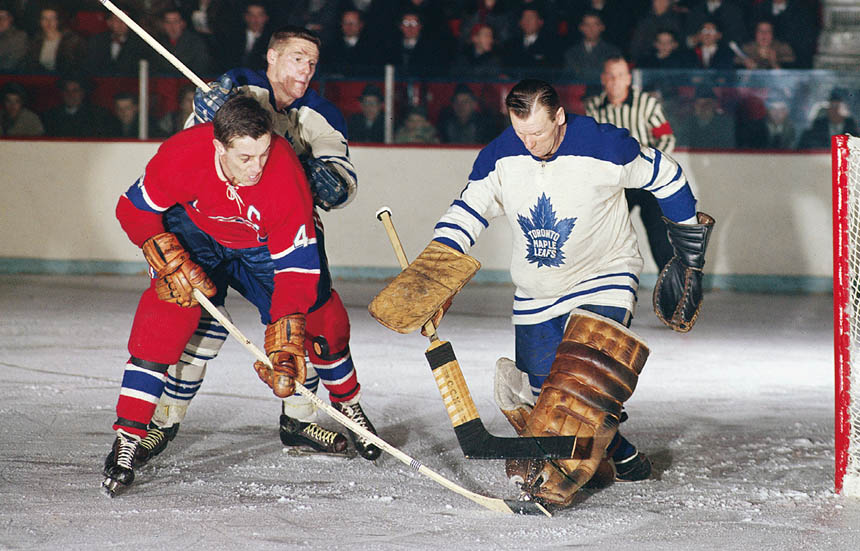
Montreal’s Jean Béliveau, here going up against Toronto’s Tim Horton and Johnny Bower, was named the winner of the Hart Trophy as the NHL’s most valuable player for the 1963–64 season when he recorded 78 points in 68 games played. It was the second time he won the award during his 20-year career.

Chicago’s Bill Hay, here in front of Jean Béliveau, was named the NHL’s rookie of the year for the 1959–60 season when he scored 18 goals and 55 points for the Black Hawks. Montreal defenseman Jean-Guy Talbot (#17) was a part of seven Stanley Cup teams during his time with the Canadiens.

Detroit’s Gordie Howe won the Hart Trophy a total of five times in his career. He earned the prestigious trophy twice in the sixties (1960 and 1963) and was a first-team All-Star five times over the same period.
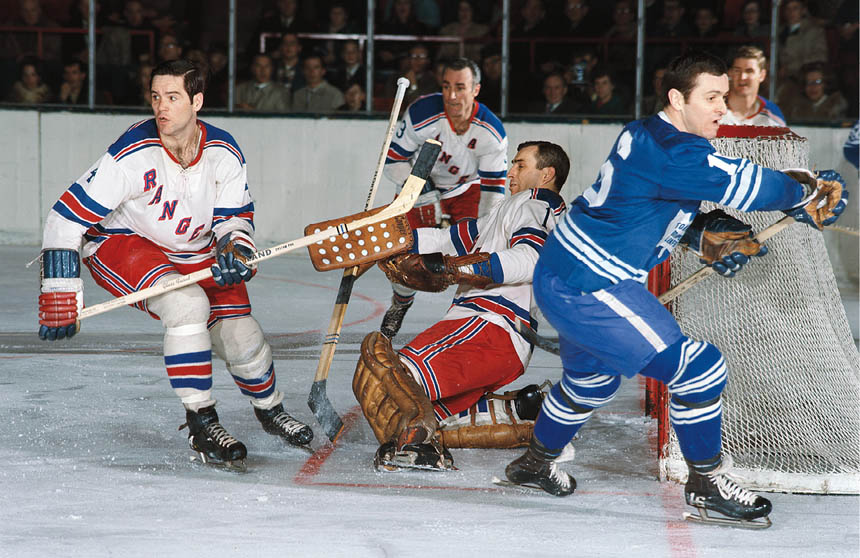
The New York Rangers finally made it back to the playoffs when they finished fourth in 1966–67, after struggling to return for several seasons. Players like defenseman Arnie Brown (#4) and goaltender Eddie Giacomin (#1) helped lead the team back to respectability.

Maurice “Rocket” Richard likely would have won the Art Ross Trophy had he not been suspended for the last three games of the 1954–55 regular season and the playoffs. Richard had 74 points in 67 games but teammate Bernie Geoffrion passed him to finish with 75 points.

Bobby Hull of Chicago gets stymied by Montreal goalie Lorne “Gump” Worsley. The portly netminder recorded a 4–0 shutout during the seventh game of the 1965 Stanley Cup finals to help the Canadiens reclaim the championship for the first time in five years.
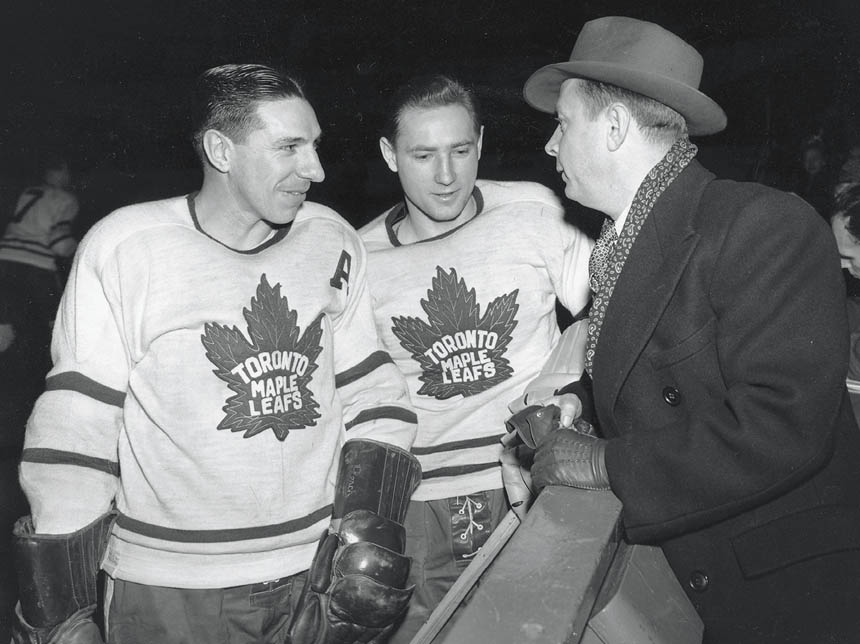
Play-by-play broadcaster Foster Hewitt was normally 54 feet above the ice at Maple Leaf Gardens when he started each game with the famous phrase, “Hello Canada and hockey fans in the United States and Newfoundland.” Here, he is at ice level with Max Bentley and Fern Flaman of the Maple Leafs.
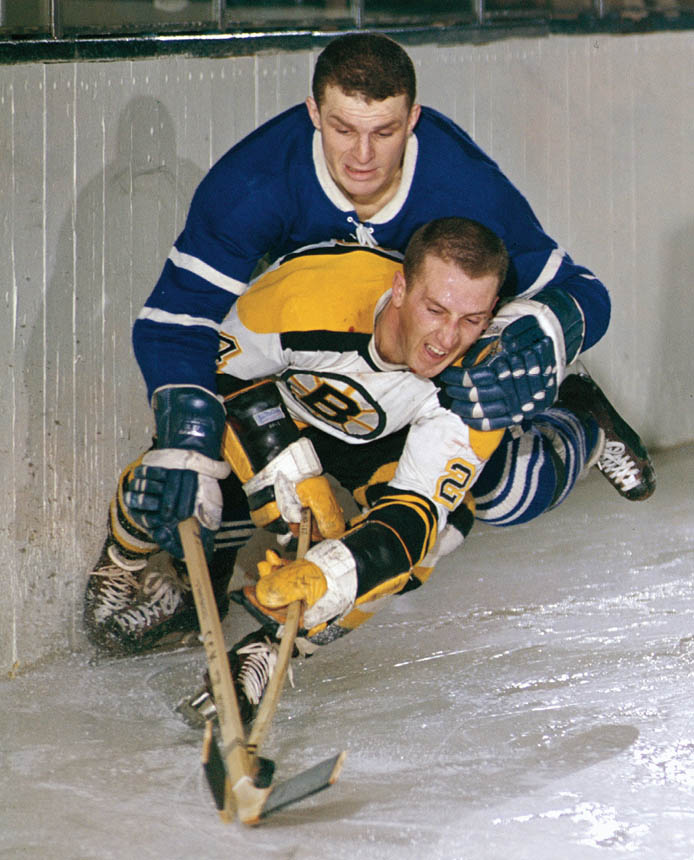
Toronto defenseman Carl Brewer is on the back of Boston forward Bob Beckett. Brewer was one of the most talented defensemen in hockey when he was with the Maple Leafs between 1957 and 1965. Beckett played in 68 career games with the Bruins between 1956 and 1964.
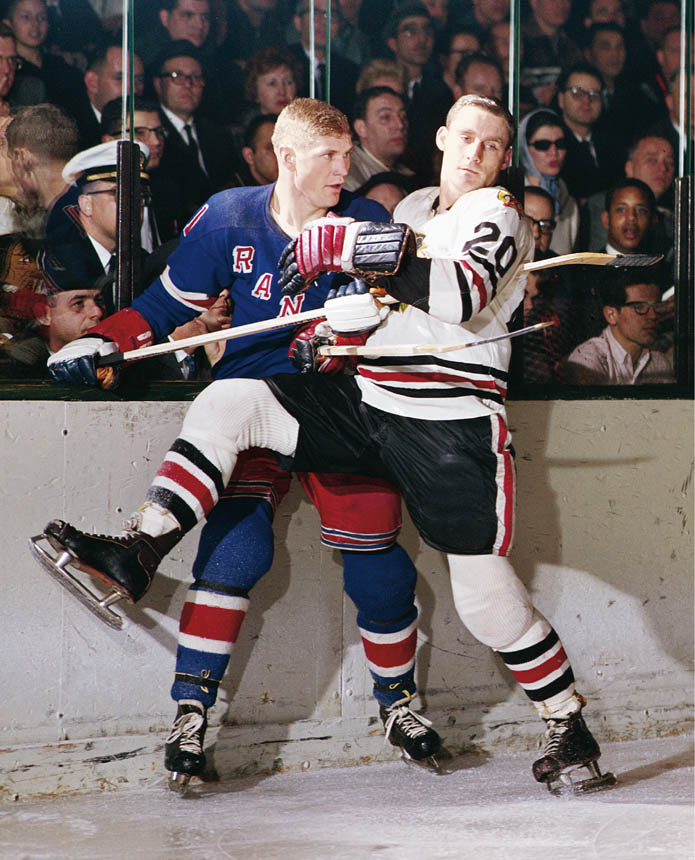
Chicago’s Wayne Hillman takes out Vic Hadfield of New York along the boards. Hillman played one playoff game in 1961 to get his name on the Stanley Cup when the Black Hawks won the championship. He went on to play for New York, Philadelphia, and Minnesota.
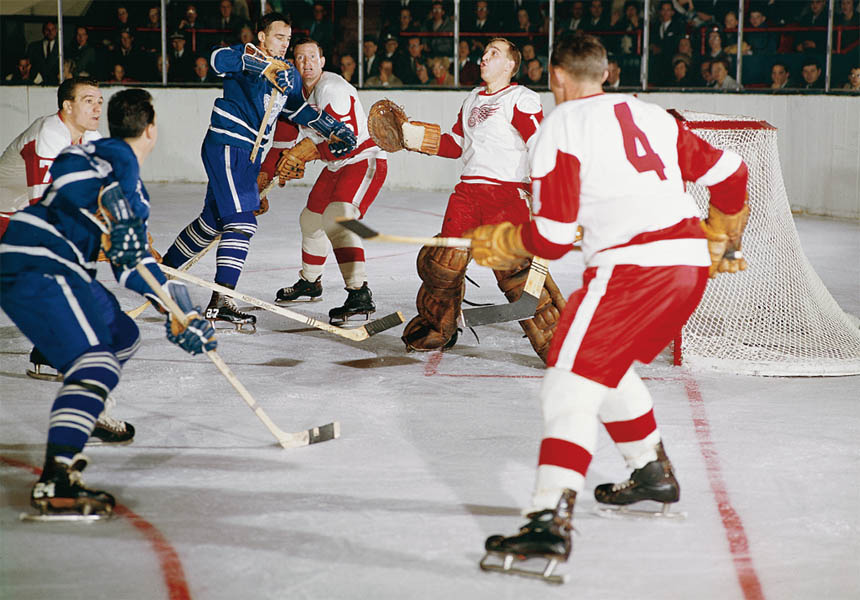
Detroit goaltender Roger Crozier was named the NHL’s top rookie after the 1964–65 season when he led the league with 40 wins. He won the Conn Smythe Trophy after the 1966 playoffs—the first player from the losing team of the Cup finals to win the trophy.
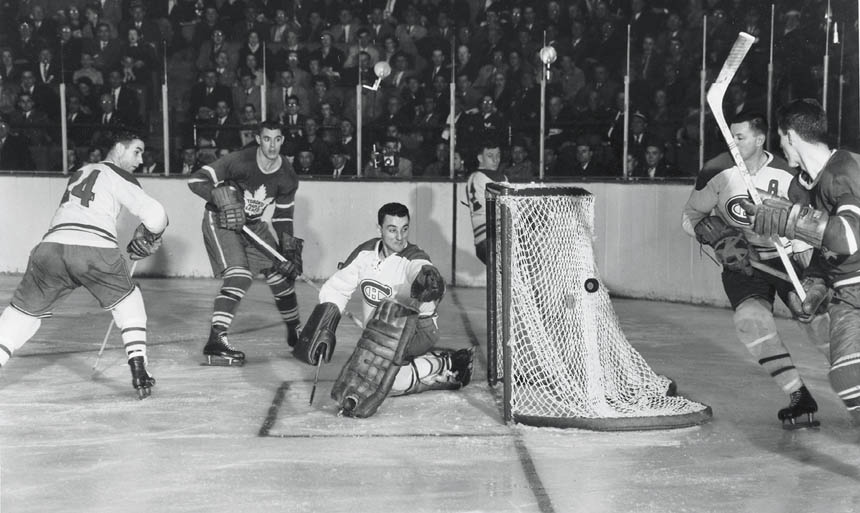
Montreal goalie Jacques Plante backstopped the Canadiens to five consecutive Stanley Cups between 1956 and 1960 and earned the Vezina Trophy as top goaltender each of those same years by allowing the fewest goals against.
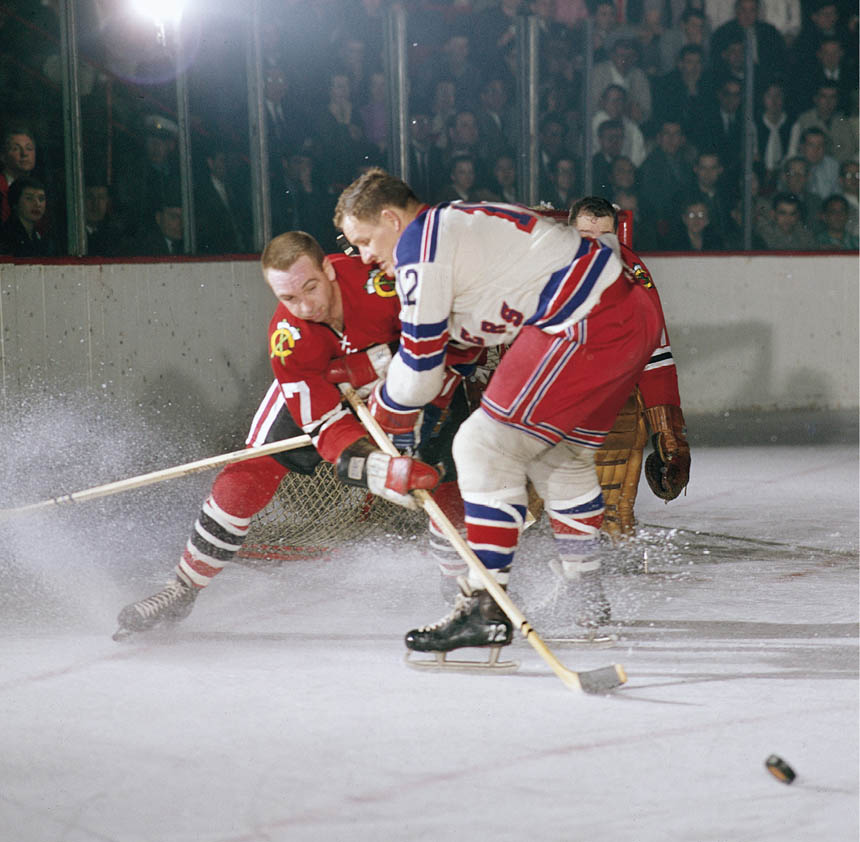
Chicago winger Ken Wharram had the best year of his career in 1963–64 when he scored 39 goals and totaled 71 points in 70 games played. New York’s Jim Mikol tries to check the speedy Black Hawk.
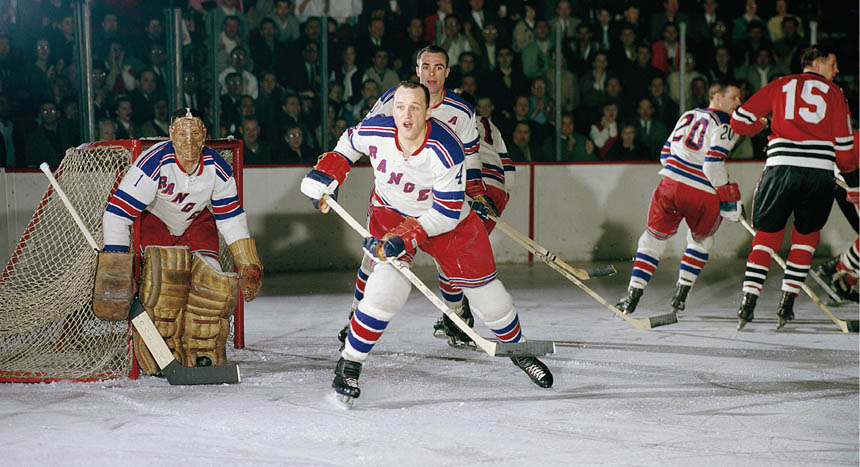
Defenseman Albert “Junior” Langlois (#4) was with Montreal for the first three seasons of his career and won the Stanley Cup each year. During his career he also played for New York, Detroit, and Boston, finishing with 112 points in 497 career games.
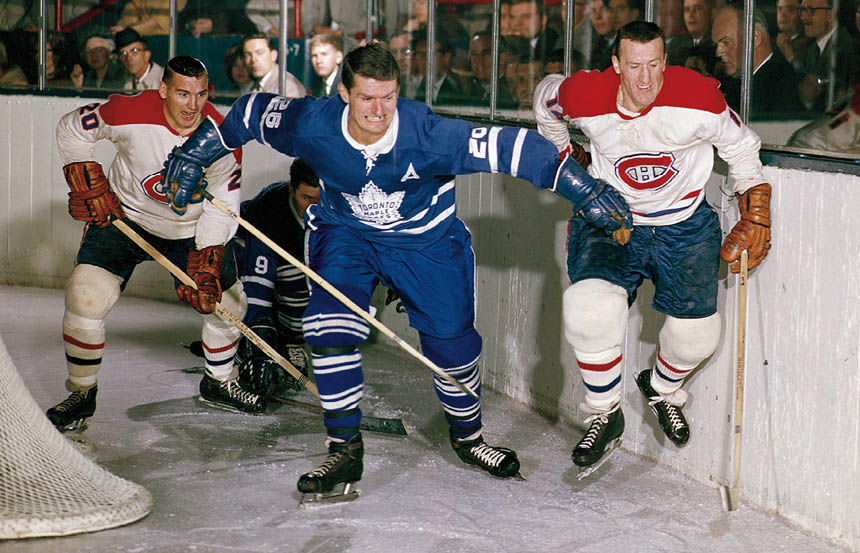
Montreal’s Claude Provost (#14), shown here battling Toronto’s Allan Stanley, did a great deal of the gritty work for the Canadiens between 1955 and 1970. One of the best checking wingers in NHL history, he still found time to score 252 goals in 1,005 career games—all for the Habs.
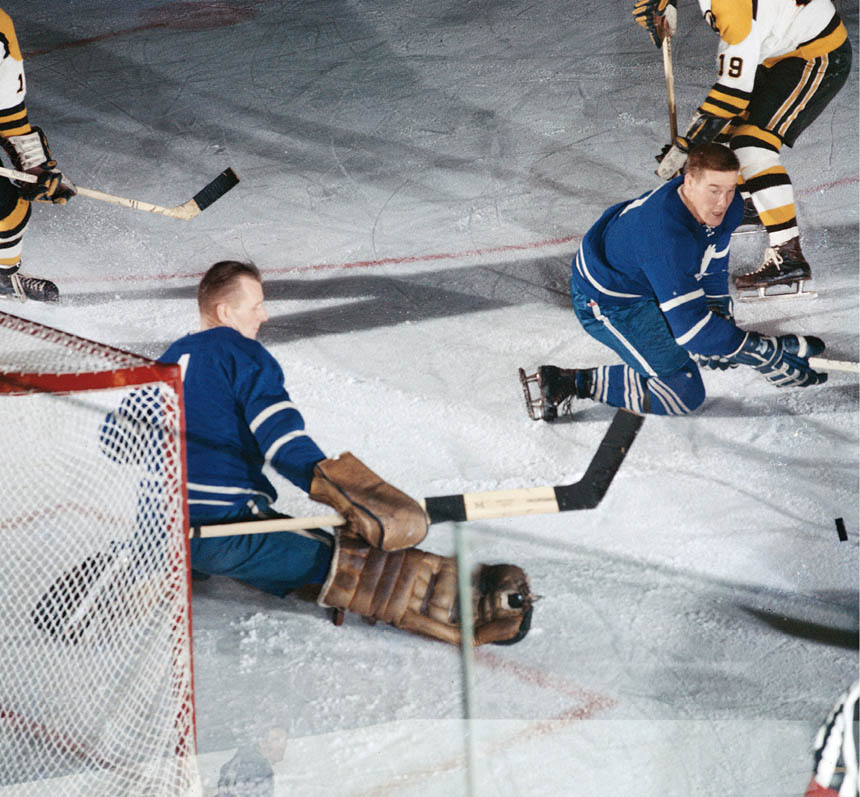
Netminder Johnny Bower was content to play in the minor leagues but a two-year contract from the Maple Leafs got the 33 year old to change his mind. In 1960–61 he won the Vezina Trophy and one year later, he led the Leafs to their first Stanley Cup in 11 years. Here he gets help from Tim Horton.

In 1965–66, Chicago’s Bobby Hull finally broke the 50-goal barrier (the first player to do so) when he finished the year with 54. Hull scored his 51st of the year on March 12, 1966, when the Black Hawks beat New York 4–2 on home ice.